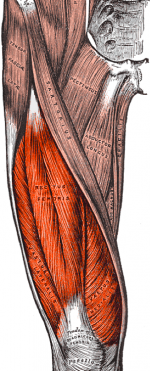Knee Extension Resistance Test
Original Editors - Yelena Gesthuizen
Top Contributors - Laura Ritchie, Lucinda hampton, Admin, Yelena Gesthuizen, Kim Jackson, Evan Thomas, WikiSysop and Wanda van Niekerk
Clinically Relevant Anatomy[edit | edit source]
| [1] |
Purpose[edit | edit source]
The extension resistance test is used to perform a maximal provocation on the muscle-tendon mechanism of the extensor muscles.
The extension resistance test is positive when the affected knee shows less power to hold the pressure. If positive we can say the extensor mechanism of the knee is disturbed.[2]
Technique[edit | edit source]
| [3] |
The patient is instructed to perform an extension of the knee joint, while the therapist exercises pressure in the opposite direction (flexion). The therapist evenly builds up his pressure, the patient is to allow no movement in the joint.
Resistance tests should be performed on both knees and compared to one another. [2]
NB: In this video, resisted testing of knee starts at 4m30s.
Key Research[edit | edit source]
add links and reviews of high-quality evidence here (case studies should be added on new pages using the case study template)
Resources[edit | edit source]
add appropriate resources here
Clinical Bottom Line[edit | edit source]
add text here
References[edit | edit source]
- ↑ ladyrain9. Knee Muscles. Available from: http://www.youtube.com/watch?v=ZIcqGUwT4oQ [last accessed 21/09/14]
- ↑ 2.0 2.1 Hagen, K., ‘Anterieure Kniepijn’, Afstudeeropdracht fysiotherapie HvU, 2005, p. 1-8. (Level of Evidence 2A)
- ↑ drjabbour. Knee Physical Examination - Flexion and Extension - Dr. Tony Jabbour. Available from: http://www.youtube.com/watch?v=fCiD3FwvwIA [last accessed 21/09/14]







